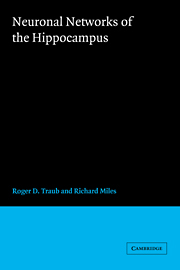Book contents
- Frontmatter
- Contents
- Acknowledgments
- Prologue
- 1 The hippocampus in context
- 2 Physiology of single neurons: voltage- and ligand-gated ionic channels
- 3 Synaptic function and organization of the CA3 region
- 4 The single-cell model
- 5 Model of the CA3 network
- 6 Collective behaviors of the CA3 network: experiment and model
- 7 Collective behaviors of the CA3 network: spontaneous oscillations and synchronized synaptic potentials
- 8 Field effects
- 9 Theoretical approaches: mathematical neural networks
- Conclusion
- Notes
- References
- Index
2 - Physiology of single neurons: voltage- and ligand-gated ionic channels
Published online by Cambridge University Press: 05 February 2012
- Frontmatter
- Contents
- Acknowledgments
- Prologue
- 1 The hippocampus in context
- 2 Physiology of single neurons: voltage- and ligand-gated ionic channels
- 3 Synaptic function and organization of the CA3 region
- 4 The single-cell model
- 5 Model of the CA3 network
- 6 Collective behaviors of the CA3 network: experiment and model
- 7 Collective behaviors of the CA3 network: spontaneous oscillations and synchronized synaptic potentials
- 8 Field effects
- 9 Theoretical approaches: mathematical neural networks
- Conclusion
- Notes
- References
- Index
Summary
In this chapter we ask how hippocampal neurons translate their synaptic inputs into an output signal sent toward other neurons. This basic question has two aspects. First, what are the firing patterns for pyramidal cells and interneurons? Neuronal firing patterns determine both how cells respond to synaptic inputs and the timing of synaptic events that they elicit in other cells. Second, what are the detailed physiological mechanisms, such as electrotonic properties or ionic-channel density and kinetics, that determine how and why a neuron responds as it does? We wish to know how a neuron functions as a device that processes its inputs that are distributed in space and time. A model of a neuron (Chapter 4) must capture the phenomenology correctly; preferably, the model will accurately represent underlying mechanisms to achieve that objective.
Before expanding on these themes, let us first consider the preparations that are used for cellular neurophysiology, with some of their advantages and disadvantages. In vivo studies are the sine qua non for understanding the normal repertoire of neuronal firing patterns and synaptic inputs and how these are correlated with behavioral states. However, stable intracellular recording is very difficult when animals are moving, such as during exploration-associated theta rhythm. Voltage-clamping cells in vivo is likely to be extraordinarily difficult.
- Type
- Chapter
- Information
- Neuronal Networks of the Hippocampus , pp. 34 - 45Publisher: Cambridge University PressPrint publication year: 1991



